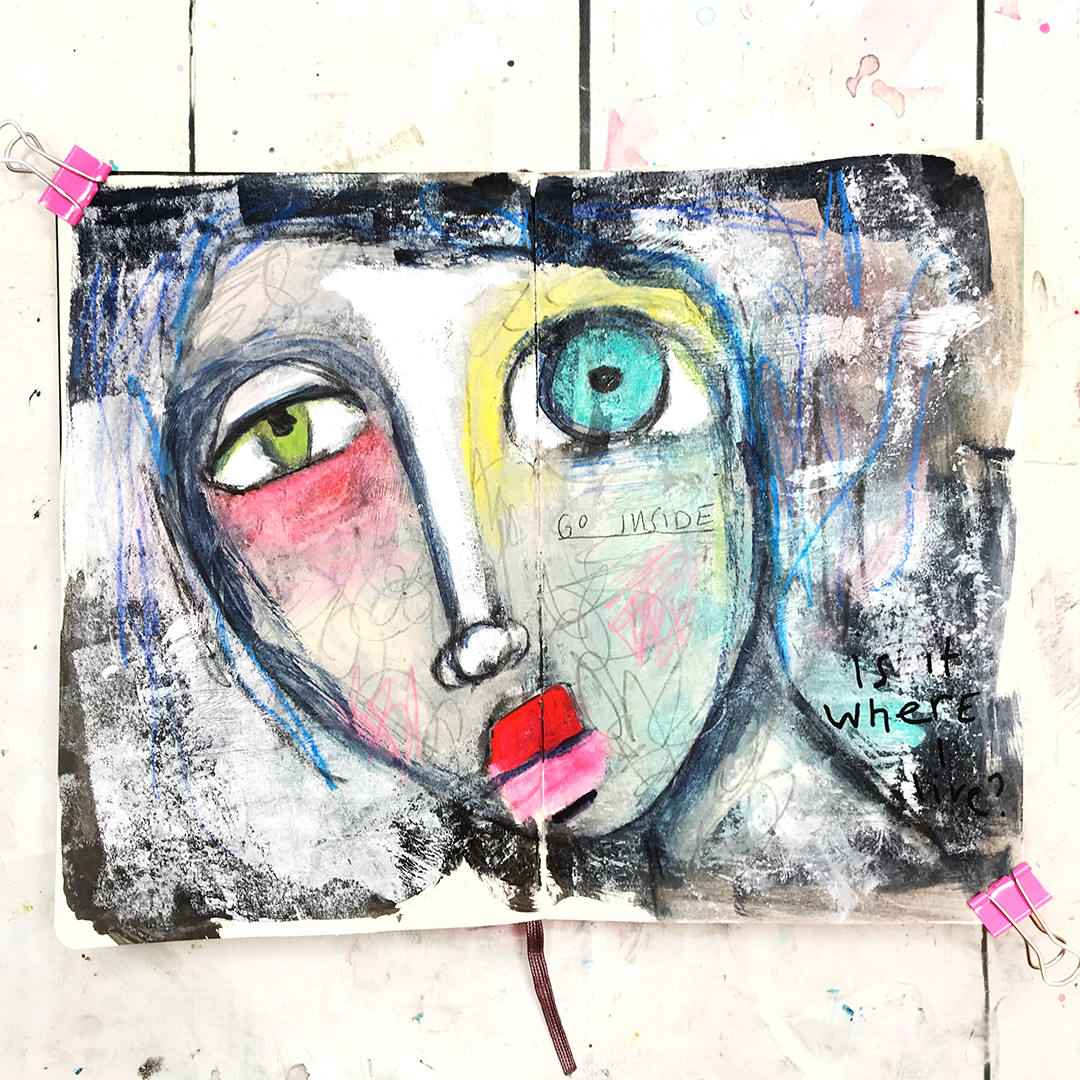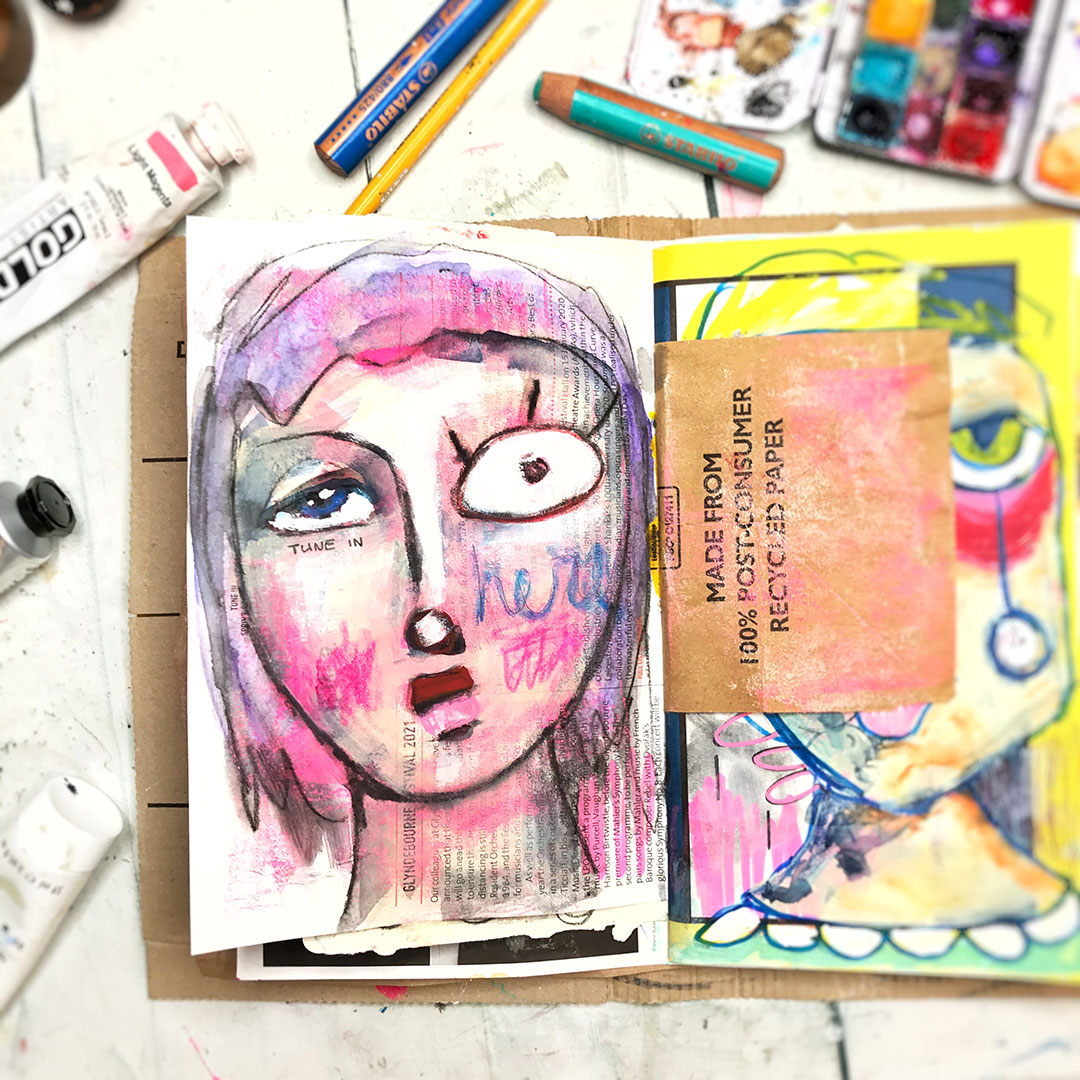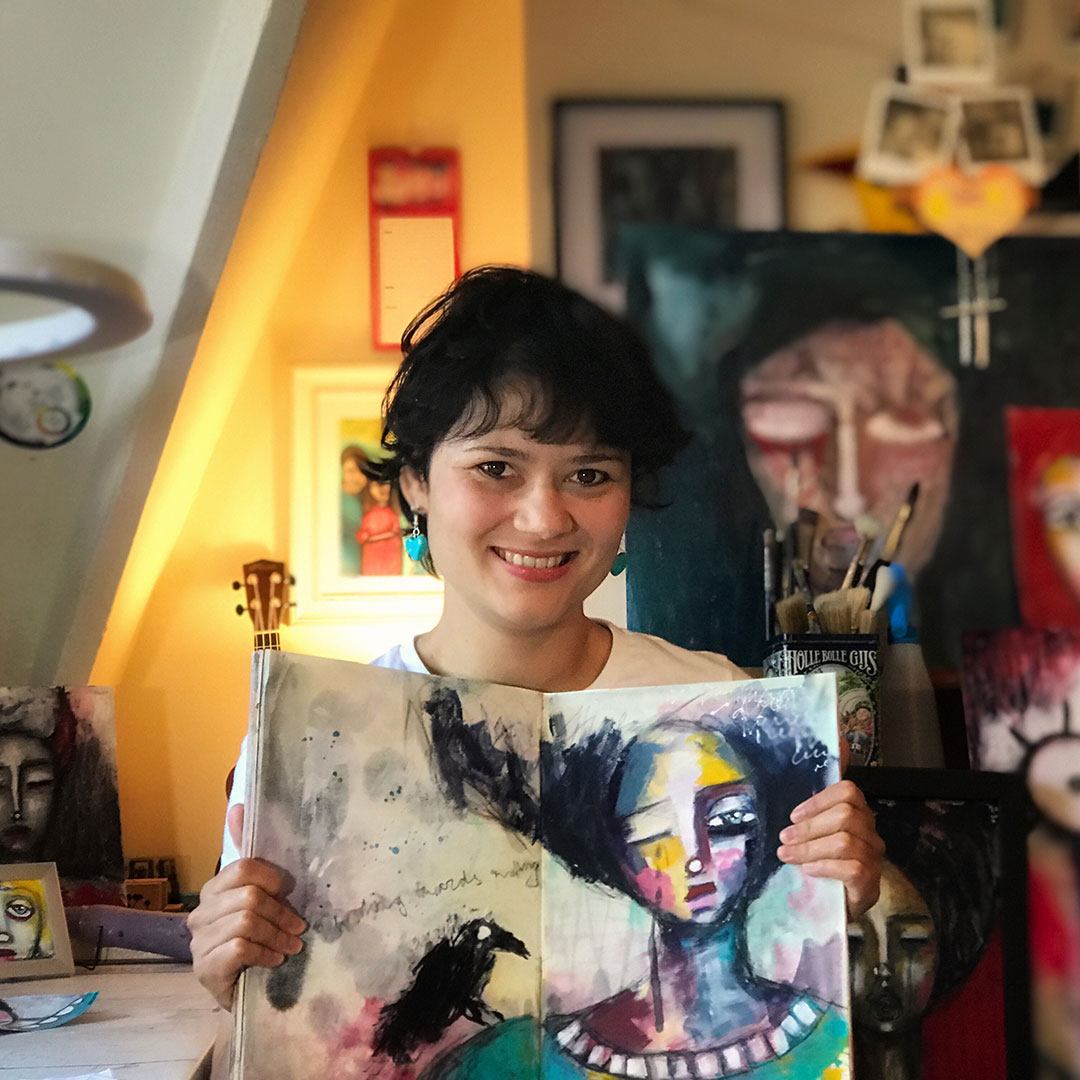Artist Spotlight
Art and feelings flow out of Iris Fritschi-Cussens into her art journal

Iris is a Dutch mixed media artist, teacher & vlogger based in London, UK. She is passionate about art and art journaling for self-expression and self-discovery. Online Iris loves to share her art, outlook and creative life through pictures, writing & videos, which she hopes will inspire those on a similar journey!
What is art journaling to you?
It is a home for my feelings, and a safe space to experiment being myself. Nowhere else do the feelings and art flow out of me as easily as in an art journal. My best art is in my journals. I haven’t decided yet whether I’m frustrated by this or grateful (probably equal parts of both).
What does community do for your art?
Community helps me feel less alone. I think loneliness is a big part of why I create in the first place, but that feeling also contributes to making it difficult to create or get started.
The art journaling community at large and the little community I have built myself have shown me that we’re all in this together: seeking connection, wanting to be seen, finding our unique path, becoming better versions of ourselves (and enthusing about the best art supplies of course!). When I can’t seem to create for myself, I create for my Patrons or my YouTube subscribers, and in doing so I usually also find my way back to myself.
How do you live a creative life? How do you incorporate journaling into that?
It was once pointed out to me that the way I do everything in life is creative (even though that’s sometimes easy to forget when there is so much laundry to do – but if you put on music and dance while folding the laundry: that’s creative!). The one thing you can never stop being is YOU and you bring yourself to every little thing you do, every experience you go through.
I believe there is a direct dialogue between ‘life’ and ‘journaling’ (if they are separate at all). Even when you’re not actively journaling, you are always absorbing, gathering, BEING, and that filters through into our artful expressions. It can be hard to feel this continuous thread, especially when pressed for time, or during creative droughts, but becoming at least intellectually aware of it has helped me a lot to trust that I am being creative no matter the moment or the activity.
What does your creative space look like? Where do you journal?
My ‘art studio’ is in the corner of my bedroom. It comprises a desk, a couple of wheelie caddies and drawer units. It’s TINY. It’s not ideal, it’s not my dream space, but it’s enough and I make it work. It’s where I do everything, from art journaling, journal creation, and planner journaling to filming YouTube videos, vlogs and art classes.
Do you have creative routines?
I’m still learning about routines and how to best help myself through using them. The hardest thing for me is the transition from ‘real life’ or ‘day job’ to creative time. This is where I get stuck most often and it’s the biggest barrier to actually creating.
If I can get myself physically into my art space I’ve already won. The most important tool I’m using for this is the humble cup of tea. It’s too hard to drag myself away from day job (‘legitimate’ urgh!) work, up the 3 flights of stairs to my creative space, just like that. So instead I make a cup of tea. It becomes the warm and kind transitional object that helps me make the journey from one space to the other, from one mode of being to another.
Once I’m in my art space, I might start by tidying up my desk, it’s part of the ritual. It brings me back to myself, in a calm state of mind. When my desk is tidy I will sit down and sip my cup of tea. This gentle transition, without a pushy goal-oriented attitude, really helps me take the necessary steps towards creativity. Bringing this concept of time into my routines, and the recognition that doing something from a standing start is nigh on impossible, means I can actually create rather than getting stuck.
What is your favourite art journal page that you’ve ever made and why?
I don’t have a single favourite art journal page, my favourites are always changing, and will usually be something I’ve made recently that just ‘feels right’.

This journal spread came together in my junk journal after having some upsetting news insensitively communicated to me and going through some days of intense sadness. The way it felt to create, the feelings it expresses and the resulting look of the spread are all in synergy together. This contributed to it being very meaningful to me and being a favourite art journal page.
What is your biggest barrier to creating? And how do you overcome that hurdle?
I already spoke about transitions as a barrier to creating. The other barrier is time. I never have enough of it, and even when I do, it can be hard to really use it productively. My whole art style is built around not having a lot of time to create. I create fast, with loose and expressive movements, I don’t stop to think or analyse, but instead I keep moving. I love the expressive and raw look this has created in my work. It also helps me to feel that even if I only have 5 minutes, I can still create something meaningful, colourful and satisfying.
Have you ever made something you don’t like? What did you do?
The hardest thing about making something you don’t like isn’t the painting or page itself, but it’s the feeling you derive from it. It can so easily become a negative spiral where you feel your art is bad, you’re bad, you’ll never make good art again etc. My favourite strategy is to just turn the page and start working on the next one. Not every piece can be a masterpiece, nor does it have to be. If you showed up and created, then you’ve succeeded.
Another thing I do with old art that I either don’t like or simply doesn’t speak to me anymore is do a paint over. I will keep the elements that I like, but paint over the bits I didn’t, and a wholly new and original work emerges. I love the fact that the new work wouldn’t have existed without the old work.
Have you ever been through artist block? How did you return to your work?
So many times! I’m realising more and more that what I thought was artist block was actually other things. Artist block is pressure to be good. Artist block is an attachment to the outcome. Artist block is thinking you’re doing it wrong somehow. Artist block is feeling you must already have ideas before painting. Artist block is never showing up at your art desk. Artist block is thinking your work should look like this or that artist’s work. Identifying what artist block actually is for me (rather than just ‘no inspiration’) means I can engage with the actual problem. Then my task becomes about showing up or playing and takes away the question of somehow ‘solving’ the artist block.
How has Get Messy impacted your creativity?
It’s one of the few places online that really embodies the message that any time spent, any little thing created, is a win, and that any art is valid. I love that the focus is on creating your own personal art practice.
Art tutorials are always useful, but beyond that, it’s so important to address how we create, how we can develop our own sustainable practices that work long term and then to celebrate our successes together. That’s something that Get Messy does really well which I haven’t found anywhere else.








Iris is one of the incredible teachers at Get Messy. She shares her art and her heart in the Season of OK.
You’re invited to embrace the messy middle and join the best art journaling community on the internet.
What journal do you use?
All of them! ALL.THE.JOURNALS. But I’m most in love with my hand-made junk journal
What is your one *must have* supply?
Black Stabilo All pencil
What do you make when you don’t know what to make?
Backgrounds or quirky faces
What is the most important (non-tool) thing to your creative practice?
Herbal tea in a huge mug
Who are your favourite Messy artists?
Caylee Grey, Roxanne Coble, Sherry McDonald, Marieke Blokland, Mindy Lacefield, Emily Looman
What’s the best art advice you’ve ever received?
“Focus on quantity, it is a much easier way to measure success. Quality will come your way I promise, just keep showing up” (if you’re wondering what infinitely wise person said that… it was Caylee Grey in the Get Messy Art book)
Advice to new art journalers:
Curate, collate and create your own favourite ways of working. Acknowledge the emotional aspects of art making that make it difficult for you. Show up and create.

